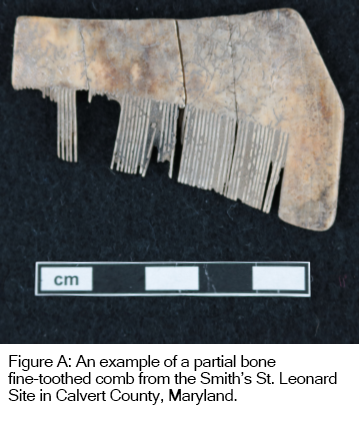Curator's Choice 2019
A Mighty Fine-Toothed Friend
December 2019
By Alice Merkel, Collections Assistant
 Of the many different pests to plague humans head lice, in particular, have continued to be a persistent companion. A single louse egg, or nit, can lead to a full infestation of the scalp if not properly cared for. As such infestations pass through contact and risk developing into epidemics such as typhus, preventative hygienic methods have been practiced by people all over the world for centuries. The earliest method of dealing with these pesky blood-sucking parasites can still be seen today when observing monkeys as they groom companions, appropriately named nit-picking. The earliest humans must have done the same, though with time our hygienic tools have vastly improved.
Of the many different pests to plague humans head lice, in particular, have continued to be a persistent companion. A single louse egg, or nit, can lead to a full infestation of the scalp if not properly cared for. As such infestations pass through contact and risk developing into epidemics such as typhus, preventative hygienic methods have been practiced by people all over the world for centuries. The earliest method of dealing with these pesky blood-sucking parasites can still be seen today when observing monkeys as they groom companions, appropriately named nit-picking. The earliest humans must have done the same, though with time our hygienic tools have vastly improved.
First carved out of ebony, boxwood, bone, and hardwood, fine-tooth combs were used to literally comb through and separate lice and their nits from the scalp (Figure A). With long, narrow teeth the double-sided one piece (Figure B) or alternative single-sided composite combs (Figure C) historically were used by everyone from the common person up to the highest elite (White 2005: 104-105).
Though lice do not discriminate when selecting hosts, the material of historical combs differs greatly depending on social status. Some of the oldest comb artifacts, made from elaborately carved ebony and ivory, show the elite classes suffered from lice just as much as the masses, who utilized hardwood and later on metal combs for their durability (Figure D). Lead combs grew popular in the seventeenth century with the belief that the material would preserve the color of one’s hair (Lester and Oerke 2004:134).
Improving on the durable metal design, vulcanite -- vulcanized rubber -- was first developed in 1839 by American inventor Charles Goodyear and later patented by his brother in 1851 (Odyssey’s Virtual Museum n.d.). This hard rubber material formed the unbreakable comb, widely popular in the 19th and 20th centuries (Figure E).
There are other lines of defense in preventing an infestation of lice, including cutting the hair short or even simply keeping the head shaved. During the 17th century, the trend of powdered wigs stemmed partially from this practice of keeping the head shaved as lice prevention. However, without proper cleaning, the pomade base, mostly made out of animal fat and boiled apples and applied on wigs before adding fine starch or wig powder, would attract parasites such as lice. These changes were only furthered with the added fragrance of delicious scents of orange flower, orris root, lavender and nutmeg (Galke 2015).
Even with proper laundering, grown lice can survive when separated from the host for nine days and their eggs as long as forty days (Rhodes Stitt 1919: 400). Beyond the nit comb, alternative solutions have been developed through time ranging from old wives’ tales of dried date powder to more modern delousing shampoos designed to drown lice. These harsh chemicals have been proven to do more harm to the human than to the pest, as seen in the 2006 FDA listed toxin lindane, a once common lice shampoo ingredient (Borden 2011). Becoming immune to the chemical washes introduced in the last century, lice have evolved and to this day there is no known method for prevention and treatment without side effects, other than nit-picking (Skerrett 2012). The best tool remains the fine-tooth or delousing comb.
| References |
| |
| American Druggist |
| 1891 |
American Druggist: An Illustrated Trade Journal 20. |
|
Borden, Jeremy
|
| 2011 |
Perils of New Pesticides. https://publicintegrity.org/business/workers-rights/a-crawling-issue-head-lice-treatments-worse-than-the-pest-itself/ accessed 12 November 2019.
|
| |
Galke, Laura
|
| 2015 |
“Perukes, Pomade and Powder: Hair Care in the 1700’s”. https://livesandlegaciesblog.org/2015/01/28/perukes-pomade-powder/ accessed 18 November 2019.
|
| |
Lester, Katherine and Bess Viola Oerke
|
| 2004 |
Accessories of Dress: An Illustrated Encyclopedia. Mineola, New York: Dover Publications, Inc. |
| |
| Odyssey’s Virtual Museum |
| n.d. |
http://www.odysseysvirtualmuseum.com/products/Hair-Comb.html accessed 5 November 2019. |
| |
| Rhodes Stitt, Edward |
1919
|
The Diagnostics and Treatment of Tropical Diseases. Philadelphia, New York: P. Blakiston’s Son & Co. |
| |
| Skerrett, Patrick J. |
2012
|
“Treatment of head lice effective with one dose and no combing.” https://www.health.harvard.edu/blog/new-treatment-for-head-lice-effective-with-one-dose-and-no-combing-201211015484 accessed 18 November 2019. |
| |
|
| White, Carolyn L. |
2005
|
American Artifacts of Personal Adornment 1680-1820: A Guide to Identification and Interpretations. Oxford, UK: Rowman & Littlefield Publishers, Inc. |